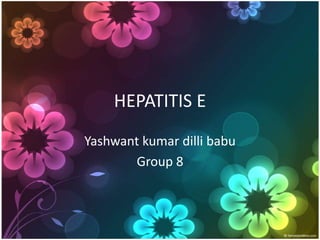
Hepatitis E Facts: Transmission, Symptoms & Prevention
- 1. HEPATITIS E Yashwant kumar dilli babu Group 8
- 3. STRUCTURE • Size: 27-nm. • Non enveloped. • Isosahedral capsid. • Positive-sense. • Single-stranded RNA. • Family:caliciviridae ,Genus:hepevirus. FECAL OR ORAL INTESTINES BLOOD LIVER BILE STOOL
- 4. STRUCTURE
- 5. DISTRIBUTION Hepatitis E is found worldwide and different genotypes of the hepatitis E virus determine differences in epidemiology. For example, genotype 1 is usually seen in developing countries and causes community level outbreaks while genotype 3 is usually seen in the developed countries and does not cause outbreaks. Globally, 70 000 deaths and 3.4 million cases of acute hepatitis E are attributable to infection with hepatitis E virus genotypes 1 and 2.
- 6. DISTRIBUTION • The highest seroprevalence rates (number of persons in a population who test positive for the disease) are observed in regions where low standards of sanitation increase the risk for transmission of the virus. Over 60% of all hepatitis E infections and 65% of all hepatitis E deaths occur in East and South Asia, where seroprevalence rates of 25% are common in some age groups. In Egypt, half the population aged above five years is serologically positive for the hepatitis E virus.
- 7. PATHOGENESIS • In monkeys, viral replication apparently causes liver damage • The immune response successfully eliminates viremia • Seroconversion marks the clearing of virus from feces and blood • Severe or fulminant cases may show sub massive and massive hepatic necrosis
- 8. TRANSMISSION The hepatitis E virus is transmitted mainly through the fecal-oral route due to fecal contamination of drinking water. Other transmission routes include: • food borne transmission from ingestion of products derived from infected animals; • zoonotic transmission from animals to humans; • transfusion of infected blood products; • vertical transmission from a pregnant woman to her fetus. • HAV in shellfish is from sewage-contaminated water and also poor sanitation.
- 9. WHO IS AT RISK? • People in overcrowed,unsanitary areas. • Children: mild disease ,possibly asymptomatic; daycare centers are major source of spread of HEV. • Adults: abrupt-onset hepatitis. • Pregnant women: high mortality associated to HEV.
- 10. CLINICAL SYMPTOMS • The incubation period following exposure to the hepatitis E virus ranges from three to eight weeks, with a mean of 40 days. The period of communicability is unknown. • The hepatitis E virus causes acute sporadic and epidemic viral hepatitis. Symptomatic infection is most common in young adults aged 15–40 years. Although infection is frequent in children, the disease is mostly asymptomatic or causes a very mild illness without jaundice (anicteric) that goes undiagnosed.
- 11. CLINICAL SYMPTOMS Typical signs and symptoms of hepatitis include: • jaundice (yellow discoloration of the skin and sclera of the eyes, dark urine and pale stools); • anorexia (loss of appetite); • an enlarged, tender liver (hepatomegaly); • abdominal pain and tenderness; • nausea and vomiting; • fever. These symptoms are largely indistinguishable from those experienced during any acute phase of hepatic illness and typically last for one to two weeks.
- 12. CLINICAL SYMPTOMS • In rare cases, acute hepatitis E can result in fulminant hepatitis (acute liver failure) and death. Overall population mortality rates from hepatitis E range from 0.5% to 4.0%. Fulminant hepatitis occurs more frequently during pregnancy. Pregnant women are at greater risk of obstetrical complications and mortality from hepatitis E, which can induce a mortality rate of 20% among pregnant women in their third trimester. • Cases of chronic hepatitis E infection have been reported in immunosuppressed people. Reactivation of hepatitis E infection has also been reported in immunocompromised people.
- 13. LABORATORY DIAGNOSIS Cases of hepatitis E are not clinically distinguishable from other types of acute viral hepatitis. Diagnosis of hepatitis E infection is therefore usually based on the detection of specific antibodies to the virus in the blood.(ELISA AND WESTERN BLOT ASSAY DETECT IgM &IgG) Two additional diagnostic tests require specialized laboratory facilities and are used only in research studies. These are: • reverse transcriptase polymerase chain reaction (RT-PCR) to detect the hepatitis E virus RNA; • immune electron microscopy to detect the hepatitis E virus.
- 14. TREATMENT • There is no available treatment capable of altering the course of acute hepatitis. Prevention is the most effective approach against the disease. • As hepatitis E is usually self-limiting, hospitalization is generally not required. However, hospitalization is required for people with fulminant hepatitis and should also be considered for infected pregnant women. • China has produced and licensed the first vaccine to prevent hepatitis E virus infection, although it is not yet available globally.
- 15. PREVENTION AND CONTROL The risk of infection and transmission can be reduced by: • maintaining quality standards for public water supplies ; • establishing proper disposal systems to eliminate sanitary waste. KILLED VACCINE,HAV:PASSIVE ANTIBODY PROTECTION FOR CONTACTS,LIVE VACCINE IN CHINA. On an individual level, infection risk can be reduced by: • maintaining hygienic practices such as hand washing with safe water, particularly before handling food; • avoiding drinking water and/or ice of unknown purity; • avoiding eating uncooked shellfish, and uncooked fruits or vegetables that are not peeled or that are prepared by people living in or travelling in highly endemic countries.
